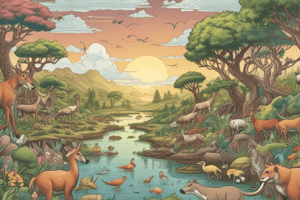Podcast
Questions and Answers
The Sun serves as the primary source of ______ input to biological systems, initiating the flow of energy through ecosystems.
The Sun serves as the primary source of ______ input to biological systems, initiating the flow of energy through ecosystems.
energy
In a food chain, energy is transferred from one organism to the next, beginning with a ______, like plants that perform photosynthesis.
In a food chain, energy is transferred from one organism to the next, beginning with a ______, like plants that perform photosynthesis.
producer
A food web illustrates the complex network of interconnected ______, showing multiple pathways of energy flow within an ecosystem.
A food web illustrates the complex network of interconnected ______, showing multiple pathways of energy flow within an ecosystem.
food chains
Organisms are classified as primary, secondary, or tertiary ______ based on their position in a food chain and their energy source.
Organisms are classified as primary, secondary, or tertiary ______ based on their position in a food chain and their energy source.
A ______ is an organism that obtains its energy by consuming dead or waste organic material recycling nutrients back into the ecosystem.
A ______ is an organism that obtains its energy by consuming dead or waste organic material recycling nutrients back into the ecosystem.
In the carbon cycle, ______ removes carbon dioxide from the atmosphere, while respiration, decomposition, and combustion release it back.
In the carbon cycle, ______ removes carbon dioxide from the atmosphere, while respiration, decomposition, and combustion release it back.
[Blank] refers to the variety of different species living within a specific area, contributing to the health and stability of an ecosystem.
[Blank] refers to the variety of different species living within a specific area, contributing to the health and stability of an ecosystem.
Deforestation leads to a reduction in biodiversity, soil loss, and an increase of ______ in the atmosphere, contributing to climate change.
Deforestation leads to a reduction in biodiversity, soil loss, and an increase of ______ in the atmosphere, contributing to climate change.
Climate change, habitat destruction, and pollution are factors that can cause organisms to become ______ or even extinct, disrupting ecological balance.
Climate change, habitat destruction, and pollution are factors that can cause organisms to become ______ or even extinct, disrupting ecological balance.
Conservation efforts, such as captive breeding programs and seed banks, aim to protect ______ species and preserve genetic diversity.
Conservation efforts, such as captive breeding programs and seed banks, aim to protect ______ species and preserve genetic diversity.
Flashcards
Principal energy source
Principal energy source
The Sun provides the main energy source for biological systems.
Energy flow in ecosystems
Energy flow in ecosystems
Energy flows from the Sun to producers (plants), then to consumers (animals), and eventually is released into the environment as heat.
Food chain
Food chain
A diagram that shows how energy is transferred from one organism to another, starting with a producer.
Food web
Food web
Signup and view all the flashcards
Producer
Producer
Signup and view all the flashcards
Consumer
Consumer
Signup and view all the flashcards
Decomposer
Decomposer
Signup and view all the flashcards
Carbon cycle
Carbon cycle
Signup and view all the flashcards
Ecosystem
Ecosystem
Signup and view all the flashcards
Biodiversity
Biodiversity
Signup and view all the flashcards
Study Notes
- The sun serves as the primary source of energy for biological systems.
- Energy flows through living organisms as light energy from the sun or chemical energy within organisms, eventually transferring to the environment.
Food Chains and Food Webs
- A food chain illustrates the energy transfer from one organism to the next, always starting with a producer.
- A food web represents a network of interconnected food chains.
- Producers are organisms that create their own organic nutrients, generally through photosynthesis, using sunlight.
- Consumers obtain energy by feeding on other organisms.
- Consumers are classified as primary, secondary, or tertiary based on their position in a food chain.
- Herbivores are animals that consume plants for energy.
- Carnivores are animals that obtain energy by consuming other animals.
- Decomposers derive energy from dead or waste organic matter.
- Overharvesting and introducing foreign species can be described using food chains and webs to demonstrate human impact on a habitat.
Carbon Cycle
- The carbon cycle includes photosynthesis, respiration, feeding, decomposition, fossil fuel formation, and combustion.
Human Influences on Ecosystems
Habitat Destruction
- An ecosystem includes a community of organisms and their environment interacting as a unit.
- Biodiversity is the number of different species living in a specific area.
- Reasons for habitat destruction:
- Increased space for housing, crop production, and livestock farming
- Extraction of natural resources
- Pollution of fresh water and marine areas
- Deforestation effects:
- Reduces biodiversity
- Extinction of species
- Soil loss
- Flooding
- Increases atmospheric carbon dioxide
Conservation
- Organisms face endangerment or extinction due to climate change, habitat destruction, hunting, overharvesting, pollution, and introduced species.
- Endangered species can be conserved by:
- Monitoring and protecting species and their habitats
- Education
- Captive breeding programs
- Seed banks
Studying That Suits You
Use AI to generate personalized quizzes and flashcards to suit your learning preferences.
Description
Understand how energy flows through ecosystems via food chains and food webs. Learn about producers, consumers (primary, secondary, tertiary), herbivores, carnivores, and decomposers and their roles in energy transfer. Also, learn the impact of overharvesting and introducing foreign species.




